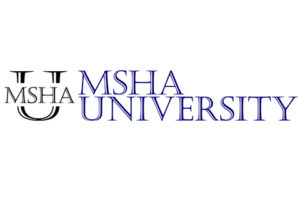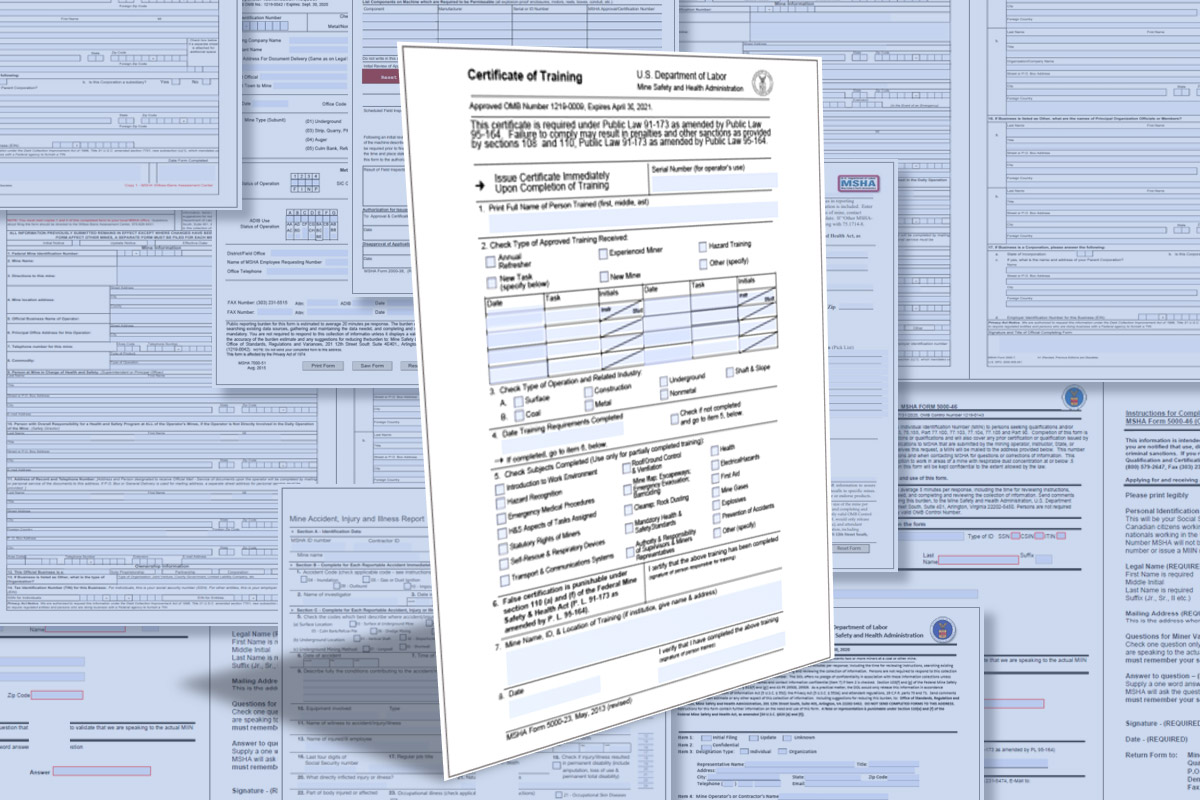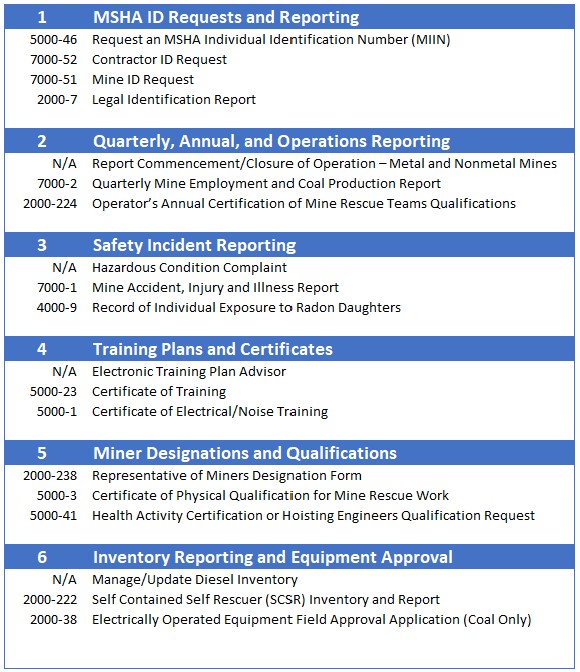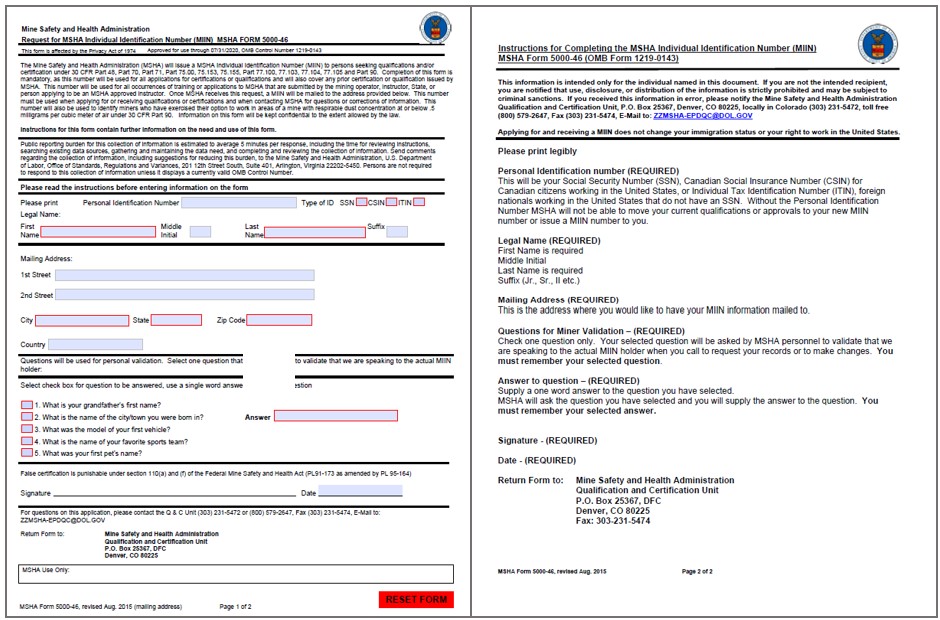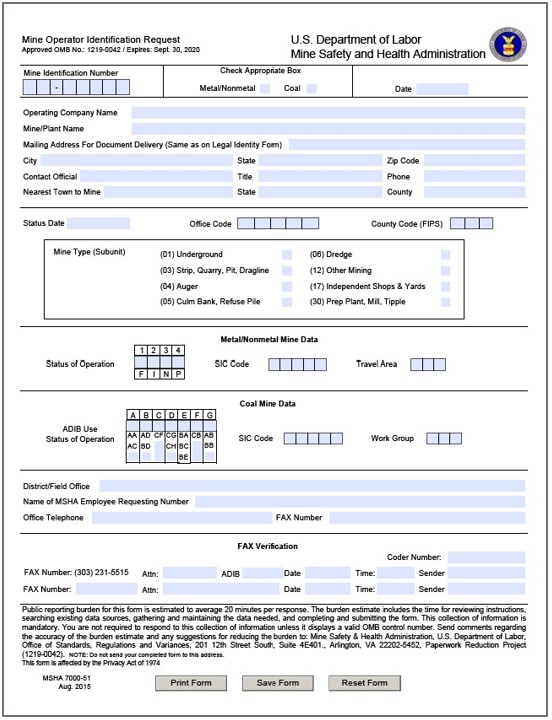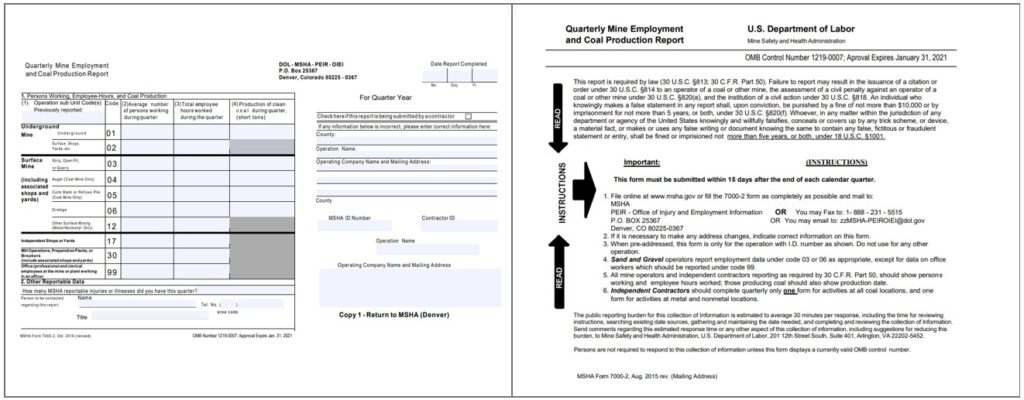While the most common questions about the Mine Safety and Health Administration’s (MSHA’s) required forms tend to focus on the 5000-23 Certificate of Training, there are many other forms that MSHA requires for a range of purposes. From training documentation and mine ID requests to accident reporting and radon exposure records, it can be a challenge to maintain compliant paperwork. And while MSHA provides online filing for most forms, many people may still have trouble locating them and understanding how to fill them out properly. In this article, we’ll offer some guidance on each of these frequently requested MSHA forms.
So, what are MSHA’s 19 most frequently requested forms? MSHA’s 19 most frequently requested forms that fall into these 6 categories:
- MSHA ID Requests and Reporting
- Employment, Production, and Operations Reporting
- Safety Incident Reporting
- Training Plans and Certificates
- Miner Designations and Qualifications
- Inventory Reporting and Equipment Approval
While MSHA typically lists these forms in somewhat random order, we’ve organized them into logical categories to make it easier to see the relationships among them. We’ve also placed them in a relative procedural order, starting with MSHA ID requests and mine commencement through training and inventory reporting. Keep in mind that this is not a comprehensive list of every MSHA form, just the most commonly requested. And while many of these forms are available for both download and to submit directly online, some are only for one or the other.
Although many MSHA forms have a numeric identifier, some don’t. Forms displayed in the list preceded by “N/A” have no official MSHA form identification number.
The table below lists each of the forms and online tools within our six categories.
1 – ID Requests and Reporting
The forms in this category are associated with an MSHA identification number, or “MSHA ID.”
An MSHA Mine ID is a unique identifying number (or 7-digit character sequence) required for each U.S. underground and surface mine site before any operations may begin. Independent contractors performing services or engaged in construction work at a mine may also apply for an MSHA Contractor ID. And certain personnel applying for specific certifications, qualifications, or approvals are required to file for an MSHA Individual Identification Number (MIIN).
Forms associated with an MSHA ID include:
- 5000-46 Request an MSHA Individual Identification Number (MIIN) – While not mandatory, all MSHA personnel mine operators, miners, independent contractors, and other MSHA qualified and certified individuals are encouraged to apply for an MIIN.
- 7000-52 Contractor ID Request – All independent contractors must apply for an MSHA Contractor ID before beginning work at a mine. (This form only allows for online filing, not downloadable.)
- 7000-51 Mine ID Request – All mine operators must apply for and be issued an MSHA Mine ID before any mining operations can begin. You can file this form both online and from the downloaded print version.
- 7000-7 Legal Identification Report – Mine operators are required to file this report within 30 days of applying for an MSHA Mine ID or to report any legal changes to the ownership of the mine. This form requires specific details about the mine, including:
- The mine ID and tax ID
- The mine name, address, phone number, and directions to the mine
- Type of commodity and mining operations
- Person in charge of health and safety
- Person with overall responsibility for all health and safety programs
- Individuals or businesses with ownership interest in the mine
2 – Employment, Production, and Operations Reporting
Before a mine can begin operation and at specified intervals during operation, the mine operator must submit several types of reports to MSHA. These reports include:
- Report Commencement/Closure of Operation – Metal and Nonmetal Mines – When filing this report online, the mine operator may select either Commencement of Operation to begin operation at the mine or Closure of Operation to temporarily or permanently cease mining operations.
- 7000-2 Quarterly Mine Employment and Coal Production Report – Although the title of this form appears to focus on coal mining, it’s intended to be used by all types of mining operations as well as mining contractors.
- Coal mines are expected to provide numbers for quarterly hours worked and short tons of clean coal produced.
- Sand and gravel mines are expected to provide the same data for their workers and the produced commodities.
- Mining contractors are expected to submit separate quarterly forms for work performed at coal mines and metal, nonmetals locations.
- Quarterly filing due dates:
- Q1 – January to March – Due by April 15th
- Q2 – April to June – Due by July 15th
- Q3 – July to September – Due by October 15th
- Q4 – October to December – Due by January 15th
3 – Safety Incident Reporting
With the idea that “safety comes first,” some may say that this category should really be at the top of the list. But we’re listing it after some other logical steps, including assignment of an MSHA ID, commencement of mining operations, and quarterly production reporting. Safety-related forms include:
- Hazardous Condition Complaint – Hazardous conditions can be anything from unstable ground conditions and dangerous erosion to poorly maintained equipment electrical hazards. Complaints can be file anonymously online or by calling 800-746-1553.
- 7000-1 Mine Accident, Injury and Illness Report – Mine operators are required to notify MSHA of emergencies that require immediate reporting within 15 minutes of the time a mine operator knows or should have known about the emergency. This form provides the mine operator a method of documenting importing details, including information on the type, location, and date/time of the accident or injury.

- 4000-9 Record of Individual Exposure to Radon Daughters – Radon daughters are solid particulate forms of radon that can be ingested and cause cancer. Mine operators are responsible for calculating, documenting, and maintaining individual miner exposure to concentrations of radon daughters annually, on or before February 15th of each year.
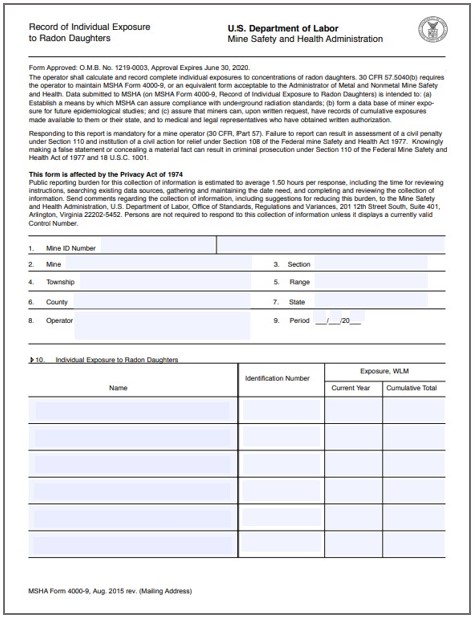
4 – Training Plans and Certificates
MSHA provides resources, guides, and templates for compliant documentation of training plans and completion records. These resources include:
- Electronic Training Plan Advisor – While not technically an MSHA form itself, this online advisor will help you put together a compliant training plan for federally required miner and contractor training.
- 5000-23 Certificate of Training – Definitely one of the most used MSHA forms, the 5000-23 also raises a ton of questions for mining contractors new to MSHA training and documentation requirements. This form is required for documentation of Part 48 (underground) miner training and provided as an option for Part 46 (surface) miner training. However, it does not need to be filed with MSHA. Simply retain it for your records and present it to inspectors upon request.
- For more details on this form, check out our article on How to Fill Out a 5000-23 Certificate of Training.
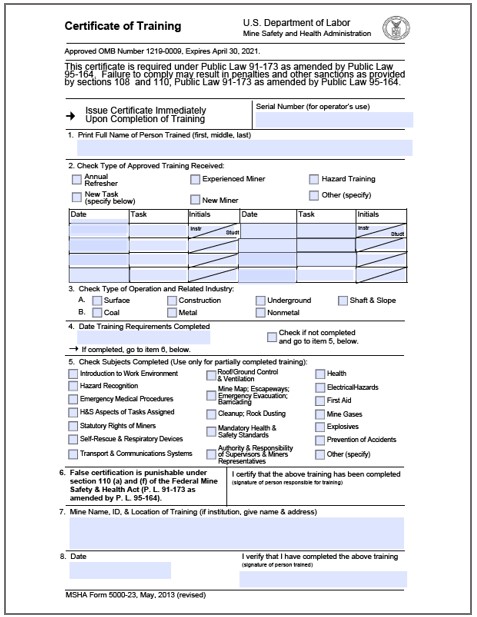
5 – Miner Designations and Qualifications
The forms in this category are intended to document designations and maintain specific qualifications for miners who may have received specialized training throughout the year. These forms include:
- 2000-238 Representative of Miners Designation Form – This is a voluntary form that designates a person as a “miner’s representative” of two or more miners at a mine. This form can be submitted at any time.
- For more details on miners’ representative, check out our article on the Statutory Rights of Miners and Their Representatives.
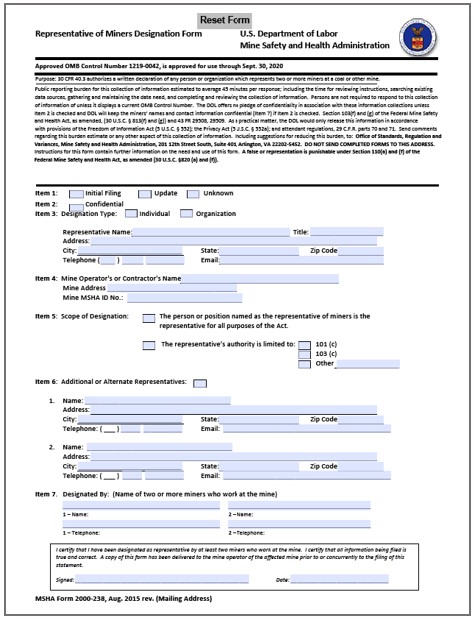
- 5000-3 Certificate of Physical Qualification for Mine Rescue Work – To be qualified and included in a mine rescue team, each member of the team must undergo annual medical examinations, with the first exam completed within 60 days of initial mine rescue training.
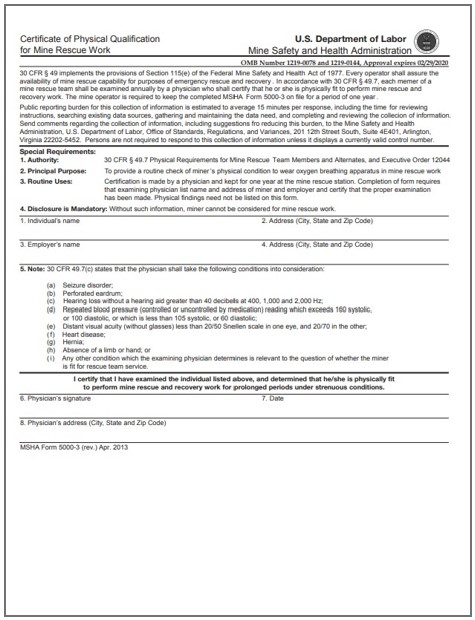
- 2000-224 Operator’s Annual Certification of Mine Rescue Teams Qualifications – This form supports MSHA’s requirement that all underground mines maintain emergency rescue and recovery capabilities. Information must be included on each miner’s completion of new miner, annual refresher, and safety apparatus training as well as participation in mine rescue contents.
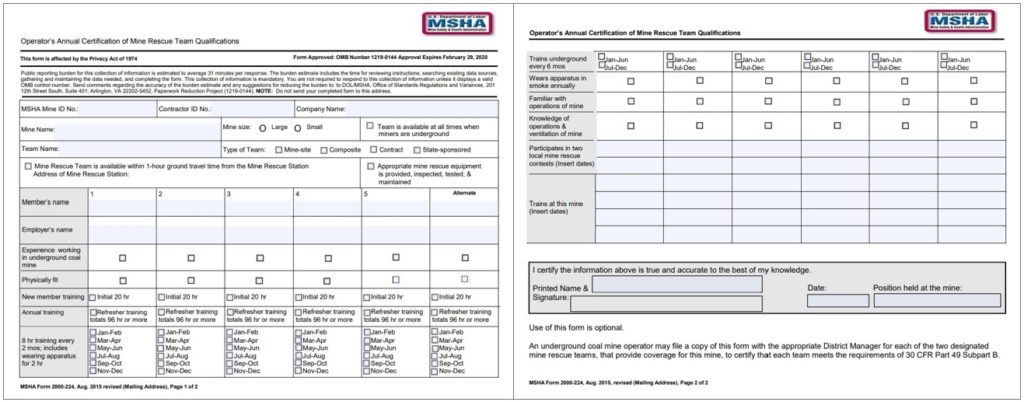
- 5000-41 Health Activity Certification or Hoisting Engineers Qualification Request – MSHA requires mine operators to submit this form to verify when mine personnel have successfully completed mine foreman and pre-shift examiner or hoisting certification training.
- 5000-1 Certificate of Electrical/Noise Training – While this form is technically a training certification, it’s primarily intended for mine operators to maintain annual certifications for qualified electrical personnel. So, we feel it falls more into this category of miner qualifications. This form requires much of the same basic information as the 5000-23. However, while the 5000-23 is completed when training is received and signed by the “responsible person,” this form must be filed annually and signed by the instructor.
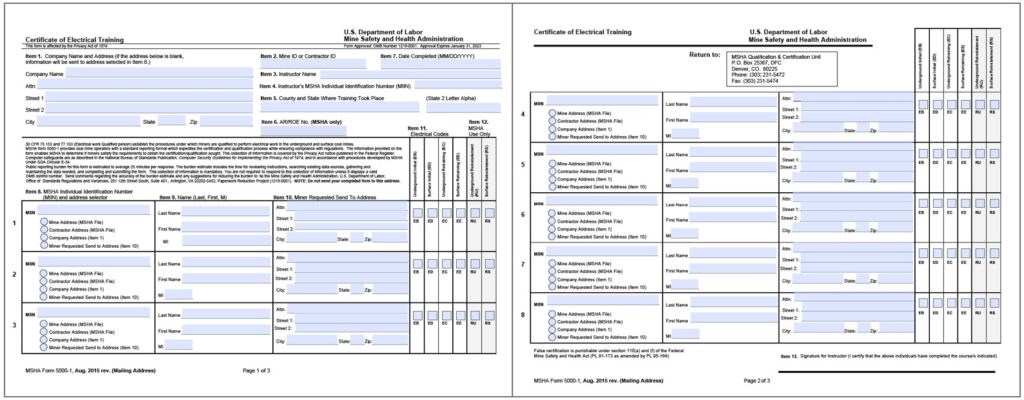
6 – Inventory Reporting and Equipment Approval
These forms and online tools allow mine operators to enter and track inventory and seek MSHA inspection and approval for electrical coal mining equipment. These forms include:
- Manage/Update Diesel Inventory – This online tool allows mine operators to update and review their diesel equipment inventory electronically. This adds to a database that’s accessible for anyone to look up the diesel equipment at any mine via MSHA’s online Mine Diesel Inventory Lookup portal.
- 2000-222 Self Contained Self Rescuer (SCSR) Inventory and Report – MSHA requires mine operators to use this form to record inventory of all self-contained self-rescue respirators (SCSRs) as well as any problems they may have with the equipment.
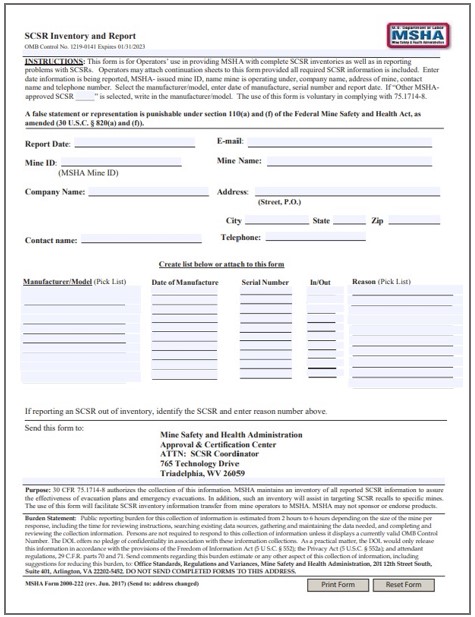
- 2000-38 Electrically Operated Equipment Field Approval Application (Coal Only) – Because of the danger of explosions in underground coal mines, MSHA places high standards on electrical equipment to prevent possible ignition of suspended coal dust or methane gas. As a safeguard for Part 48 coal mine operators, MSHA provides this form to request an inspection of electrical equipment that has been either professionally assemble and installed or built by the coal mine operator.
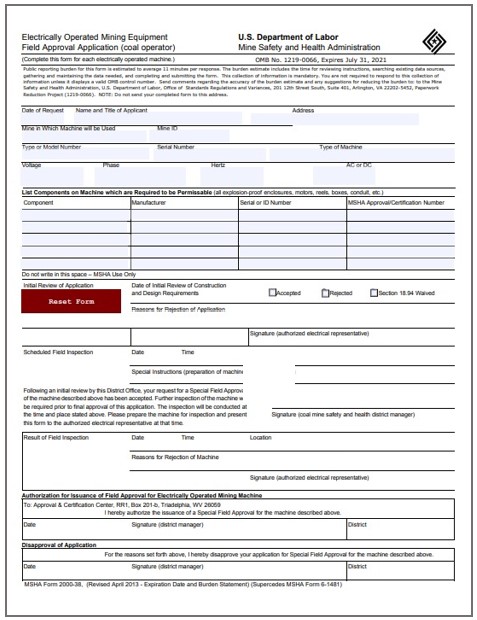
Getting Help from MSHA
For help filing any of these forms, contact MSHA directly at 877-778-6055 or by email at desk.help@dol.gov.
If you have any questions about this article, feel free to CONTACT US. Please keep in mind that MSHAU.com is a private company not affiliated with the Mine Safety and Health Administration (MSHA).
